I’ve never been able to jump very high… thanks a lot, genetics. I was, however, able to increase my vertical by nearly 6 inches through the implementation of various explosive leg exercises.
The key to being able to jump higher is training your quads, glutes, calves, and hamstrings. And, not just training them for strength, but training them for explosiveness.
These are 21 of the best exercises to jump higher.
1. Jump Squat
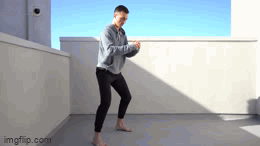
The Jump Squat is one of the best exercises to increase your vertical. There is some pretty strong evidence that proves how effective it is in helping you jump higher. And, it make sense…
The muscles used when performing a Jump Squat are identical to the muscles used when jumping. They are also used in the exact same way. It only makes sense that it would be one of the best exercises for increasing your vertical.
The exercise itself is very simple.
How to perform a Jump Squat:
Standing with your feet shoulder-width apart, drop down into a squat (keeping your head up and back straight). Then, explode up, jumping as high as you can. Make sure to land on the balls of your feet (not your heels) and lower yourself into another squat.
Repeat.
2. Box Jump

The Box Jump is another great (plyometric) exercise to isolate your legs and help you jump higher. Again, this exercise focuses on explosiveness which is critical for an increased vertical.
The Box Jump utilizes the same muscles as the Jump Squat. The main difference with this exercise is the use of the box forces you to jump a certain height. Additionally, you can gradually increase the height of the box to help hit new personal bests.
How to perform a Box Jump:
With the box in front of you, stand with your feet shoulder-width apart. Begin by dropping down into a squat (keeping your head up and back straight). Then, explode up, jumping on the box with both feet. Make sure to land softly while keeping a slight bend in the knees.
Step back down. Repeat.
3. Jumping Lunges
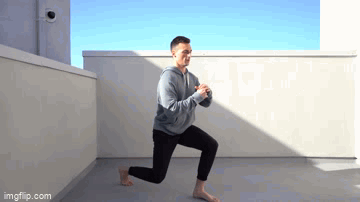
Jumping Lunges are a great way to blast your legs and improve your vertical.
The thing I like most about this exercise is it targets each leg individually, which ensures a balanced leg workout. It also trains two important stabilizer muscles that are used when jumping.
The erector spinae (which stabilizes your spine) and the transverse abdominis (which stabilizes your core) are both engaged when performing jumping lunges. Strengthening these muscles will help add inches to your vertical.
How to perform Jumping Lunges:
Start with your feet hip-width apart. Taking a big step forward, lower yourself into a lunge. Make sure you keep your hips centered over your legs and your back upright.
Then, explode up, jumping off the ground. While in the air, switch feet and land with your opposite foot forward. As you land, lower yourself back into a lunge.
Repeat.
4. Jump Rope (Double-Unders)
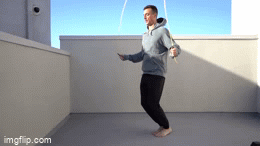
One of the best jump rope variations to improve your vertical is Double-Unders. Double-Unders are one of the most explosive jump rope movements. While they strengthen your quads and hamstrings, they engage your calves the most.
The strength (and girth) of your calf muscles has a proven, positive correlation with vertical jump height.
Conceptually, Double-Unders are pretty simple. However, they’ll likely take some practice to master.
How to perform Jump Rope Double-Unders:
The trick to performing a successful Double-Under is quick wrists. You need to rotate the rope around your body twice for every single jump.
Start by jumping rope. Keep your knees slightly bent, elbows tucked to your side, and wrists pointed outwards. Jump slightly higher and rotate the rope twice around your body. This rotation is accomplished by moving your wrists (not your arms).
Repeat.
5. Goblet Squat
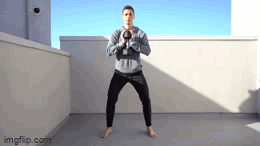
I have a love-hate relationship with Goblet Squats.
The Goblet Squat is probably one of the most effective exercises to help build lower body strength, specifically in the quads and glutes. That said, they burn like hell!
They’re absolutely worth adding to your regimen, though.
The strength of your glutes has been shown to have a fairly substantial impact on how high you can jump. In one 8-week study, participants who implemented a gluteal muscle-specific exercise program showed significant improvements in their jump height, flight time, speed and power.
How to perform a Goblet Squat:
Start by standing with your feet shoulder-width apart and your toes pointed slightly outward. Holding the dumbbell (or kettlebell) close to your chest, drop down into a squat. Make sure to keep your back straight, engage your core, and keep your head up.
Explode up, returning to starting position. Repeat.
6. Jumping Jacks
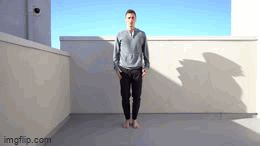
Jumping Jacks are another solid exercise to help you jump higher. And, they’re super underrated!
Jumping Jacks are actually a full body workout, working both the upper and lower body. The muscles that are engaged the most, however, are the glutes, adductors, hamstrings, quads, and particularly the calves. The same muscles utilized when jumping.
There are a variety of Jumping Jack variations you can perform, too, which can help stimulate muscle growth. One of my favorites is using battle ropes while jumping.
If you’re not familiar with Jumping Jacks, they’re pretty simple.
How to perform Jumping Jacks:
Start by standing with your feet together and your arms at your side. In one motion, jump your legs out to about shoulder-width apart and stretch your arms out over your head. Complete the Jumping Jack by jumping back to the starting position (legs together, arms by your side).
Repeat.
7. Straight Leg Deadlift
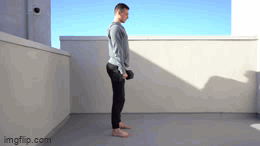
The Straight Leg Deadlift, also known as the Romanian Deadlift, is a common exercise performed by powerlifters, among other athletes. It’s a great exercise to stimulate muscle growth (hypertrophy) and increase your vertical jump.
The exercise itself primarily targets your hamstrings and glutes, while also working your lats and erectors. The increase in both strength and flexibility in your posterior chain will greatly increase your ability to jump higher.
To avoid injury, I suggest starting with lightweight or bodyweight.
How to perform a Straight Leg Deadlift:
With your feet about shoulder-width apart and your knees slightly bent, pick up the barbell (or dumbbells). Make sure to keep your back straight and your head up.
Begin the exercise by bending at the hips (not the knees), bringing the weight just past your knees. The key here is to keep your knees locked in position and only hinge at the hips. You should feel a deep stretch in your hamstrings.
Return to the starting position, keeping your core tight and flexing your glutes.
Repeat.
8. Step-Ups
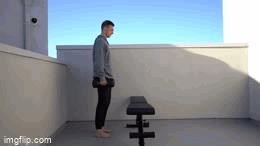
This is another exercise which you should definitely be doing if you’re looking to jump higher.
Similar to Jumping Lunges, Step-Ups do a wonderful job of targeting each leg individually. They also work the lower body muscles in a really dynamic way. This exercise works your quads, hamstrings, and glutes.
I typically do these using dumbbells, but if you’re new to this movement I’d suggest starting with body-weight.
How to perform Step-Ups:
Find a chair, bench or step stool. Begin standing in front of the chair with your feet shoulder-width apart. If you’re using dumbbells, pick up one with each hand.
Step up on the chair with your left foot, pressing through your heel and glute to straighten your leg. Bring your right foot up to the chair. Complete the movement by bringing your right foot back down and stepping off the chair.
Repeat this with each leg individually, or alternate with each rep.
9. Calf Raises
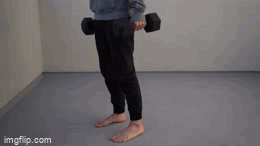
Training your calf muscles is one of the easiest ways to add inches to your vertical.
There are several ways you can target them, too. One of my favorites is the Calf Raise. Specifically, the Standing Calf Raise. These can be done seated, as well.
The calf muscle group is made up of two muscles, the gastrocnemius and the soleus. Calf Raises will primarily work the gastrocnemius, which is the larger muscle of the two.
I typically do these with weights, specifically dumbbells. However, you can do these using only your body-weight, too.
How to perform a Calf Raise:
Start by standing on the edge of a step or stair. If you’re using weights, pick up one dumbbell with each hand. Keeping your back straight, a slight bend in your knees, and your head up, lower your heel over the edge of the stair. Make sure to keep the balls of your feet planted on the stair.
Raise your heel a few inches above the stair, hold for a moment, then return to starting position.
Repeat.
10. Wall Sit
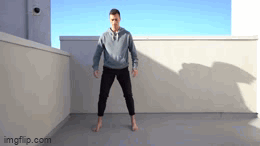
While this exercise isn’t the most “explosive”, it’s still a great exercise to add to your regimen when looking to boost your vert.
You’re probably familiar with Wall Sits, too. If not from your middle school gym class, then maybe from when your parents disciplined you for skipping your middle school gym class. If not, don’t worry, they’re pretty easy to perform.
The Wall Sit primarily targets your glutes and your quads, both of which are critical muscles used when jumping.
How to perform a Wall Sit:
Find a wall. Begin by putting your back up against the wall and lowering your butt to create a 90 degree angle with your legs. It’s important to keep your core engaged and ensure your knees don’t cross over your toes.
Hold for set duration. Repeat.
11. Kettlebell Swing
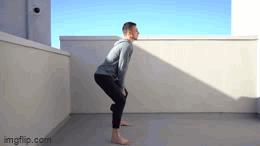
The Kettlebell Swing is another exercise that can add some serious height to your jump. If I had to choose one exercise to help increase my vertical, this would be it.
And they’re fairly easy to perform, too.
The movement itself targets a variety of muscles, most importantly the hamstrings, glutes, quads, and hips. The mechanics and explosive nature of this movement have been proven help athletes jump higher.
How to perform a Kettlebell Swing:
Start with your feet shoulder-width apart. Pick up the kettlebell (or dumbbell). Keep your arms straight and hold the kettlebell with an overhand grip.
Begin the movement by bending at the knees and lowering your butt back and down. Exploding up from your heels (through your hips) driving the kettlebell out in front of you. Allow it to swing out and then back down between your legs.
Repeat.
12. Bulgarian Split Squat
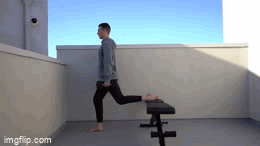
The Bulgarian Split Squat is another exercise that does a great job targeting each leg individually. It’s also a great exercise to help you jump higher.
The muscles engaged in this exercise are the glutes and quads, while also working the soleus and adductor magnus. It can be done with a barbell, dumbbells, or using only your bodyweight. If you’re new to this exercise, I suggest starting with no weight.
How to perform a Bulgarian Split Squat:
Find a bench or a chair and stand about 2 feet in front of it.
With your feet about shoulder-width apart, lift your left leg up behind you, placing the top of your foot on the bench. Keeping your back straight and your core engaged, lower yourself into a lunge. Try and keep your knee from passing too far over your toes.
Repeat.
13. Sumo Squat
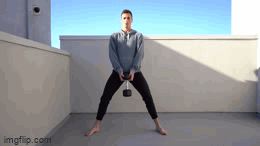
The Sumo Squat is a hugely underrated lower body lift. It’s also a great alternative to the traditional squat, especially for anyone dealing with mobility issues.
The exercise itself targets your entire lower body, including your glutes, quads, calves, hips and adductors. Once you have the basic mechanics and form down, there are some solid variations you can implement to make it more difficult.
Try a Sumo Squat to Kettlebell Swing, or a Sumo Squat Jump, for a more explosive exercise.
How to perform a Sumo Squat:
Start by standing with your feet slightly wider than shoulder-width apart and your toes pointed outwards. Keeping your core engaged and your back straight, lower your body down into a squat.
Make sure to drive up from your heels through your glutes.
Repeat.
14. Squat
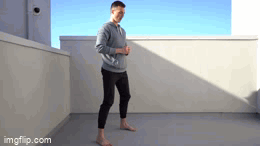
Nothing fancy with this one, I had to include it on the list though. The traditional Squat should be a staple exercise for anyone looking to jump higher.
The Squat works out the entire lower body, including your abs and upper back (Thoracic Spine). It’s probably one of the most important lifts when looking to develop stronger legs.
If you’re new to this movement, I suggest starting with lighter weight to avoid injury.
How to perform a Squat:
Start with the barbell on your upper back and your feet about shoulder-width apart. Keeping your back straight and core tight, lower you butt/hips down and back. It’s important to keep your head up and chest out while performing the Squat. And, try to keep your knees from crossing over your toes.
I usually shoot to get my thighs roughly parallel with the ground, then return to starting position.
Repeat.
15. Deadlift
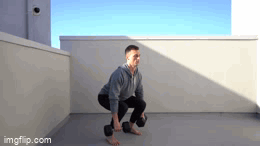
The Deadlift, like the Squat, should be a staple in your workout regimen if you’re looking to jump higher.
This exercise works out a variety of muscles in both your legs and back. The glutes, quads, and hamstrings are all engaged when performing a Deadlift.
In regards to explosive movements like jumping, the Deadlift seems to be “significantly similar to the peak muscle activation of a vertical jump”.
How to perform a Deadlift:
Approach the center of the barbell and stand with your feet about hip-width apart. Your toes should be under the bar, with the bar only an inch or two from your shins.
Begin by squatting down, pushing your butt down and back. Keep your back straight, shoulders back, and head neutral. Grab the bar with your preferred grip. The bar should now be touching your shins.
Lift your chest up and straighten your lower back. Stand up with the weight, utilizing your legs and keeping your core tight.
Repeat.
16. Glute Bridge
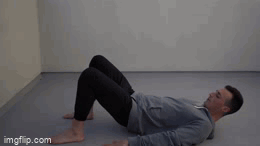
The Glute Bride isn’t commonly thought of when talking about developing lower body strength. It’s definitely an underrated exercise, though.
One of the things I love about this exercise is it targets a variety of stabilizer muscles you don’t normally engage with other lower body exercises. And, there’s evidence that suggests stronger stabilizer muscles can positively effect “vertical takeoff velocity’’.
How to perform a Glute Bridge:
Start by lying on your back with your feet hip-width apart and your knees bent.
Engaging your core and squeezing your glutes, lift your hips to a bridge. Make sure to drive up from your heels (not your toes). Hold at the top, squeeze, and then return to starting position.
Repeat.
17. Dumbbell Shoulder Squat (Front Squat)
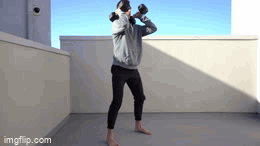
The Dumbbell Shoulder Squat, also known as the Front Squat, is a solid exercise for building lower body strength and increasing your vert.
The thing that I like about this exercise, unlike the traditional Squat, is how it targets the quads. These are guaranteed to develop the front of your thighs.
The secondary muscles worked with this exercise are the glutes, inner thighs, and calves.
How to perform a Dumbbell Shoulder Squat:
Pick up your set of dumbbells.
Standing with your feet about shoulder-width apart, raise the dumbbells up and rest them on your shoulders. Try and keep your elbows as close to parallel with the ground as possible. Keeping your chest up and your core tight, lower yourself into a squat. It’s important to bend simultaneously at the hips and knees. Keep your back straight.
Pause when your thighs are parallel to the ground, then return to starting position.
Repeat.
18. Side Lunge
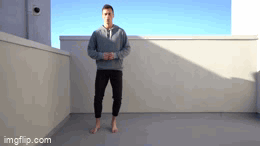
The Side Lunge is a great exercise for any athlete, regardless of their training goals.
There are several benefits from incorporating Side Lunges into your routine. The main muscles it works are the quads and glutes. That said, they work the inner and outer thighs in ways the traditional Lunge doesn’t.
Additionally, you can incorporate dumbbells for added resistance or perform Jumping Side Lunges for a more explosive workout.
How to perform a Side Lunge:
Start by standing with your feet hip-width apart. Take a wide step out to the side with your right leg. Bend at your knee and push your hips/butt down and back. Make sure to keep your back straight.
Push off with your right leg, returning to starting position. Then take a wide step with your left leg.
Repeat.
19. Duck Walk
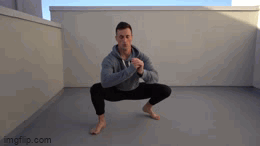
While it may look a little silly, the Duck Walk is actually a solid exercise.
The primary muscles worked are the glutes, quads, and hip flexors. And, as a secondary muscle, the hamstrings. The reason this exercise made the list is due to how it engages the hip flexors.
The hip flexors are an important group of muscles to develop for increasing your vertical jump. According to various studies, stronger and more flexible hip flexors resulted in “significantly enhanced jump height”.
How to perform a Duck Walk:
Start by standing with your feet about hip-width apart.
Lower yourself into squat by bending your knees, pushing your butt back, and lowering your hips towards the floor. Keeping your chest up and extending your arms out in front of you (for balance), begin to walk. Make sure to maintain the squat as you walk.
Repeat.
20. Hip Thrusts
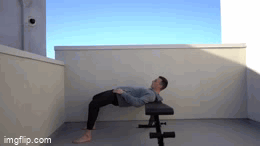
This is another exercise that probably isn’t being discussed much in terms of helping you jump higher. It should be, though!
Hip Thrusts primarily target the glutes, both the gluteus medius and gluteus maximus. It also engages the hamstrings, and to some extent your quads, core, and hip adductors.
You can do this exercise with or without weight.
How to perform a Hip Thrust:
Begin by lying your upper back/shoulders on the bench. Your knees should be bent and your feet flat on the ground.
While squeezing your glutes and pushing up through your heels, drive your hips towards the ceiling and form a straight line from your shoulders to your knees. Your body should be parallel to the floor.
Hold for a moment at the top, then lower yourself back to starting position.
Repeat.
21. Jump Rope (High Knees)

Jump Rope High Knees are another great jump rope variation that can do wonders for being able to jump higher.
They’re super simple, too!
The primary muscles this exercise works are the glutes, calves, and quads. It also engages the rectus abdominis and hamstrings, just not as much as the first three muscles.
How to perform Jump Rope High Knees:
Start by jumping rope. Keep your knees slightly bent, your elbows tucked to your side, and your wrists pointed outwards. Once you find your rhythm, raise one knee up bringing your thigh roughly parallel with the ground. Jump on one leg. Once you have that down, try alternating knees between each jump.
Think of it as running in place as you rotate the rope around your body.
Repeat.
